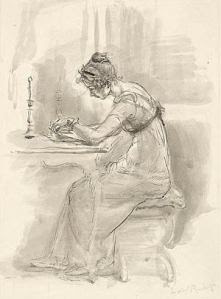The day has arrived. Sharpe’s adventures in India begin tonight with Sharpe’s Challenge. And don’t forget to mark your calendars for Sharpe’s Peril, which will air on April 4th. Huzza!
Category: Uncategorized
“Beauty is Truth, Truth Beauty ”
 Although I am far from an expert on Keats, I found the film quite moving. And historically accurate, with beautiful settings and costumes. Except for one thing. As a good friend remarked, why didn’t they film it at the actual house where it all happened in Hampstead, just north of London? I visited the Keats House years ago and it is a treat! Here is the real house that Keats and Fanny’s family lived in.
Although I am far from an expert on Keats, I found the film quite moving. And historically accurate, with beautiful settings and costumes. Except for one thing. As a good friend remarked, why didn’t they film it at the actual house where it all happened in Hampstead, just north of London? I visited the Keats House years ago and it is a treat! Here is the real house that Keats and Fanny’s family lived in.Tea and an Interview
 Charmed by author Elizabeth Boyle’s sense of fun and spirit of playfulness, Victoria and Kristine accepted Elizabeth’s kind invitation to join her in a cyber tea. They dished and ate and dished some more about all things historical, about Number One London and about their upcoming trip to London. Elizabeth has put their conversation up on her website so that you can eavesdrop on all the fun. While you’re there, don’t miss taking a trip around the N.Y. Times best selling author’s witty website.
Charmed by author Elizabeth Boyle’s sense of fun and spirit of playfulness, Victoria and Kristine accepted Elizabeth’s kind invitation to join her in a cyber tea. They dished and ate and dished some more about all things historical, about Number One London and about their upcoming trip to London. Elizabeth has put their conversation up on her website so that you can eavesdrop on all the fun. While you’re there, don’t miss taking a trip around the N.Y. Times best selling author’s witty website. For Sale – Chester Terrace, London – £9,500,000 (Sigh)
Fine Grade II Listed Home – Designed by John Nash, this house was built by John Burton in 1825. One of the most handsome and successful of the terraces, its characteristic features are the archways which link the individual parts.
•6 bedrooms
•3 reception rooms
•4 bathrooms
•412.17 sqm
Contact Stephen Lindsay at Knight Frank +44 (0)20 7586 2777
The Incomparable Jane Austen
by Victoria Hinshaw
As a lover of Jane Austen, I regret I could not attend the Morgan Library’s exhibition that just closed in New York City. I know several people who saw it and all of them were mesmerized by the display of letters and a manuscript in Jane’s hand.
But in this age of the internet, we are fortunate to have wonderful resources right on our computer screens. So I encourage you to go to the Morgan site and feast your eyes on the films and exhibits available there. You won’t be disappointed.
Below you see Jane’s Chawton Cottage in Hampshire as it appeared in May 2009, with its scaffolding. Substantial renovations were finished last year, 200 years since Jane Austen, Cassandra and their mother moved to the house. Jane Austen lived here for the last years of her life. Scholars seem to agree that she did her finest work here, both writing full novels and refining previous versions for publication. Visit Chawton Cottage here. One of the additions since I last visited a year ago is the reopened kitchen in which Jane helped to prepare breakfast. Now I have to go back.
One of my favorite “pictures” of Jane is below, where she is portrayed as going Hollywood. It is probably apocryphal, but a story has circulated of the Hollywood studio CEO, who, upon reading a script based on Austen, said, “What else will she write for us?”







